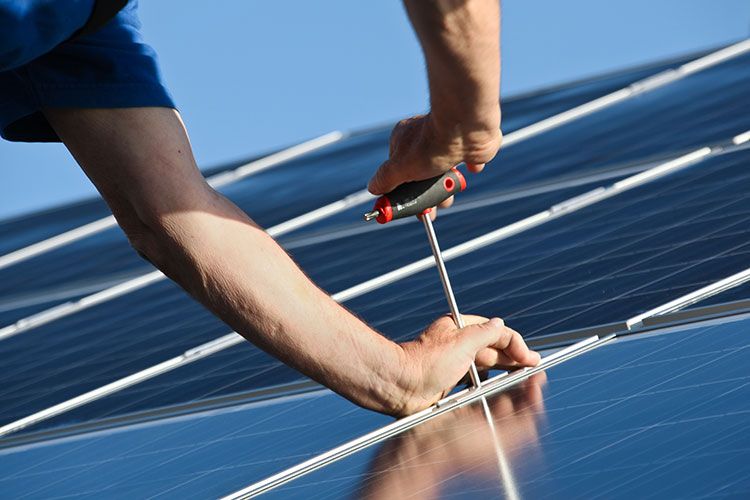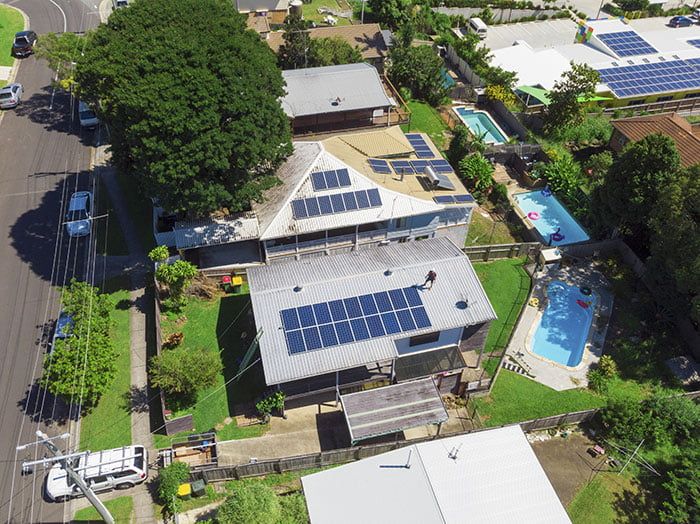Your Guide to the Solar Rebate.
Are you interested in purchasing a solar system kit for your home or business? Perhaps you already have one installed and you are thinking about increasing its size. Going solar has so many benefits, which is why Australians are more interested than ever. One of these benefits is the rebate, aside from the amount of money you can save when you do not need to pay energy bills.
Unfortunately, there has been a lot of speculation lately about the solar rebate in Australia getting cancelled. Consumers and even solar companies are getting more concerned each day. It is in the TV news and online write-ups. But what is the truth about it?
This blog post will talk about everything you need to know about solar rebates and whether or not they will be scrapped as what companies are saying.

Solar Rebate vs Feed-In Tariff
First off, it is necessary to know what is a solar rebate? It is different from feed-in tariffs that many consumers confuse the rebate with.
To sum it up, a solar rebate is a federal government rebate while a Feed-in Tariff (FIT) works just like a buyback scheme. In this case, when your solar system produces more energy than you need, you can send it back to the grid. You will get paid for doing so, on behalf of Western Power and typically through Synergy if you are in Western Australia.
When you install a solar system, you can opt to feed the energy back to the power grid. It then qualifies you for a feed-in tariff, which is a payment for the energy your solar system sends to the grid. The amount you get will depend on the excess energy you give back. There are two main types of FITs, which are:
- Gross FITs: This is when all the energy will be fed back to the power grid at a premium price. Any electricity you use during a period should be paid just like the regular consumers.
- New FITs: This option is for you to give only the extra energy you produce back to the grid. It will then allow you to reduce your bills. However, the amount of money you get from the feed-in tariff will depend on the electricity you use.
Whether it is the rebate or feed-in tariff, you can save with a solar system.
How the Solar Rebate Works
In Western Australia, the government pays for half of your system. This federal rebate works off the number of panels you have. It is why many companies will tell you that you should get as many panels as you can. This way, you can maximise your rebate.
When you talk to a solar company after you have decided to have a system installed, the price that will usually be quoted to you is your out-of-pocket expense. As a consumer, you want to know how much you will truly pay to get a solar system on your roof, along with the rebate. The federal rebate is based on a multiplier, depending on the number of panels you have.
When you purchase the solar system, you will be awarded “certificates” that will be sold to power companies or other entities, such as the solar panel installer. Therefore, you can use them to offset the installation or the price of the panels themselves.
How Solar Rebates Affect the Cost of Solar Systems
When you get a quote for a solar system that you plan to purchase, you should know that companies will typically consider the rebates as part of the price. These rebates are mostly the STCs. Therefore, you should be wise and ask certain questions before you buy. Enquire about the following:
- What is the upfront cost of the solar system that I will pay?
- How much of the STCs are deducted from the price?
- Is the STC based on the market price? Or is it a fixed clearing house price for the certificates?
- Are there other rebates or options that will help me reduce the cost of the solar system?
- What is included in the quote?
If the STCs are based on the market price, the cost could be based on the value of the STCs after the installation. Small business owners should understand that they may be able to claim the costs of installing the solar system as part of the tax-deductible assets. You may want to check with your accountant or you can reach out to the Australian Taxation Office to learn more.
How to Get Rebates
Rebates exist so people can be motivated to go solar. The system does become less expensive, which incentivises consumers to have solar panels installed. Not everyone is eligible for a rebate. Your system should not exceed 100kW in size. Your solar photovoltaic panels should be approved first, and only a certified professional should install them.
EasySolar would typically sell a 6.6kw package for single-phase power in Western Australia, along with a 5.5kw inverter. This particular package entitles you to 109 certificates, which have an equivalent amount in dollars. Each panel has a certain amount of watts, which is equal to a rebate value.
Now, what are these certificates? They are small-scale technology certificates or STCs, which are for homeowners and small business owners. If you buy solar panels, you are entitled to these certificates. Those who purchase solar hot water systems can also be granted with STCs.
The value of the STCs depends on how you obtained them. Typically, their worth is based on market demand. You can use the STC calculator that the government provides, which allows you to get an estimate of the STCs you can receive.
What if you have an old system? The good news is that you can still get a rebate if you take it off and renew it. The condition is that you change the inverter to a new one and not just the panels. It works well for those who have small systems, but are planning to switch to a bigger one. If you are among them, you will only pay the out-of-pocket expenses.
Calculating STCs
These certificates can be quite difficult to calculate on your own. As part of the Solar Credits program of the Renewable Energy Target of Australia, every megawatt-hour (mW/h) may qualify for renewable energy certificates (RECs). These RECs include the small-scale technology certificates that are designed for residential and small business solar installations that do not exceed 100kW in size.
Before you can calculate the total STCs, you should determine where you live, the dollar value of the certificates (fluctuating), and the deeming period that lowers every year. After getting all these items down, you will know the STCs by taking the solar system size in kilowatts, multiply it with the postcode zone rating and the deeming period. Round down the answer to getting the total number of STCs.

The Truth About Solar Rebate “Cancellation”
To make it easy for you, here is the clarification you need: the cancellation is not real. You can breathe a sigh of relief now. Many companies will tell you these rebates will end soon so you will be encouraged to buy now and have the system installed. They will tell you that you should not miss out on the opportunity to save.
In truth, the government has a rebate program called small-scale technology certificates as discussed above. These certificates have an inherent value that will decrease over time.
Therefore, if you have heard about the horror stories regarding rebates ending, what will happen is that the multiplier is reducing. In essence, it will end in a specific period. For instance, you purchased a solar system last year. Your subsidy would be equivalent to 118 certificates (roughly around $35) until the end of that year.
On the first of January this year, your rebate will be equal to 109 certificates. By next year, it will be 100 certificates. In other words, the system then will cost you more because of the multiplier changes yearly. It will change for the next 12 years, as per government policy.
The current legislation, therefore, shows that the solar rebate began to lower in value from January 2017. By that time, 1/15th of the original rebate will be deducted until it reaches zero by 2032. At this point, it is still a long way to go.
Many consumers are worried about the rebate being eliminated. Much of this agitation stems from the media that has caused several people to make assumptions about this topic. In reality, the rebates getting scrapped have no confirmed danger whatsoever.
It should be noted though that the Australian Competition and Consumer Commission (ACCC) recommended for the rebates to be removed. In July, the ACCC published a report about the restoration of affordability of electricity to aid in the country’s competitive advantage. The report has over 50 suggestions on how to lower the grid electricity costs.
The 24th recommendation was to get rid of the Small-scale Renewable Energy Scheme (SRES), which is the solar rebate, in 2021. The SRES reduces the cost of solar for homeowners and even small business owners. Although the report did have some valid arguments, smart consumers did not want to jump in.
The reduction in power bills will help households all over Australia. However, the proposal will only result in only one per cent decrease. Also, there is the likelihood that the price will once again increase over the long term. An interesting point here is that the ACCC did not recommend that privatisation should be reversed, which can give actual results.
It remains to be seen whether or not the Federal Government will accept the ACCC’s recommendations and enact them, particularly the one about solar rebates.
The subsidy does seem untouched – for now. Consumers should be aware that the dollar value of the rebate can reduce all of a sudden if the demand for solar system significantly increases. The system is designed to regulate itself. If the market is hot, the rebate will reduce for the STC price, which is anywhere from $0 to $40 as stated by the law.
When the STC price is high, the more rebates you can receive. Although the rebates will decrease over time, there is no way to predict what the price will be by next year – or even next week. However, since the law has limited its value, it will never be more than $40 unless amended.
In the end, even the Clean Energy Regulator site does not call this rebate a rebate. Nevertheless, it is a government program that can benefit you. In a way, it does become an incentive to buy solar panels. After all, you can get a “rebate” or discount against the upfront cost of the installation.
How to Truly Benefit From the Rebate and the Solar System
Before you start buying a solar system, it makes sense to know whether or not you qualify for the rebate. This financial incentive is not available to everyone. If you want to take advantage of it, you should meet the following requirements:
- The panels are less than 100kW in size.
- A professional should install your system approved by the Clean Energy Council.
- The inverters and panels should be Clean Energy Council-approved as well.
The incentive is beneficial for every consumer, especially because solar systems are not that cheap. Although their prices have dropped quite significantly, many people still want to know how much they can get off the solar system price. After the subsidy, you are probably wondering how much the system will cost you as well.
The answer will depend on a variety of factors. If your system is 3kW, the approximate amount of subsidy you can get off the cost of the solar system will be around $1,890. Here is a breakdown of this calculation:
- The rough estimate for the rebate today is $630 for every kilowatt.
- $1,890 is the product of $630 and 3kW.
If you go for a larger system, you will surely get a bigger rebate. However, you cannot get the subsidy if you go beyond 100kW, as stated above.
Understanding the benefits is one thing but choosing the right solar company is to trust is another. Never settle for those that offer a small price in exchange for hidden fees. Many inexperienced salespeople will try to give you false information. It is why you should do your research first, especially when it comes to rebates.
Clients can do the rebate work themselves. They will pay for the system in full and claim the rebate. The process, however, takes longer. Additionally, you need to have upfront cash for it.
EasySolar gives you the easiest process. Send a copy of your power bill, front and back. Date of birth of the person on the bill. EasySolar does the approvals. The energy buyback scheme works off with a retailer’s reference number, which EasySolar will need to give to Western Power for approval. A straightforward application will mostly be approved instantaneously.
For applications that are much more complicated, particularly those that are past 5kw, EasySolar experts will have to create line diagrams and other technical assessments. The good news is that consumers never have to worry about these things.
Finally, while rebates will not disappear yet, it does make sense to buy sooner rather than later. To ensure that you save money, you should get quotes from a reliable company. The amount of rebate, as mentioned above, will depend on the current price of the STCs on the market. For instance, if the price is $37, the rebate you will receive will be around $630 per kW of panels installed on your rooftop.
In the coming years, solar is expected to be in high demand. More and more consumers will want to get rid of their high power bills and invest in solar energy instead. Due to the high demand, several STCs will then be generated. As the STC increases in supply, the prices will decrease in general. As a result, the subsidy will also plummet.
Also, take note that the solar panel rebate that you can claim will depend on where you live. As a consumer, all these pieces of information can be quite overwhelming. It is why you need a trustworthy solar company and installer to guarantee that you get the value of rebate that you are entitled to. Only EasySolar can provide you with these benefits.

The Future of the Rebate
In the Federal Government side of things, the rebates will stay but will decrease for the next 12 to 15 years. The technology though will get better and the prices will even drop. Right now, solar systems in Australia are at rock-bottom prices.
With those details out of the way, EasySolar believes that there is a better chance of saving money. If the state government will provide rebates to batteries, consumers will get the true value of solar power. It was discussed that feed-in tariffs will be eliminated. Purchases of batteries may be granted rebates instead. Calculations are still in the process, but it may be the next step in the future.
Western Australia has a very limited scheme for energy rebate though. It is why many citizens find it difficult to pay their bills. Feed-in tariffs are still around but they can be scrapped altogether.
Your solar system will eventually pay off. How long it will take depends on several things, including the power requirements of your home, the total cost of the system you have purchased, and the size of the unit. You can also factor in the rebates and other benefits you receive from buying the solar system.
The weather and your eligibility for a feed-in tariff and rebate will also affect the timeframe to get your investment back. However, if you are using solar power on your own, you will see the savings on your electric bills in just a few years.
One thing to know is that while consumers should take advantage of rebates, they are not the only reason why solar systems should be installed. The benefits of going solar go beyond these incentives. Contact EasySolar today to find out how you can save on your next solar system package.






